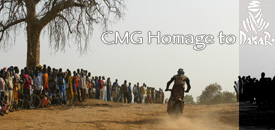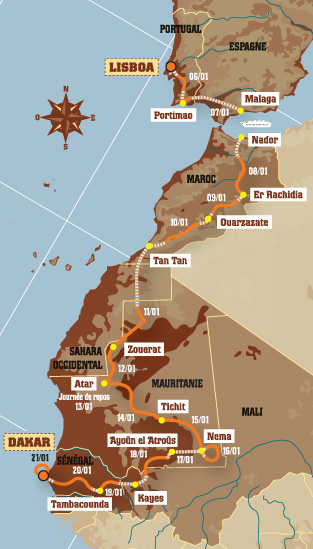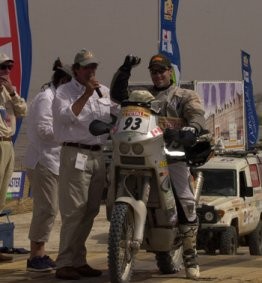|
|
|||||||||
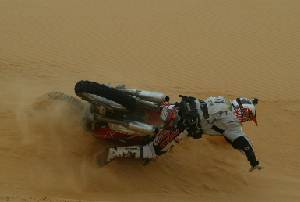 |
|
Shit happens – Especially during the Dakar Photo: Maindru Photo |
Just about everyone and their dog (and their dog’s best friend for that matter) has heard about the Paris-Dakar rally. And why not, as it’s the biggest and best-known rally in the world ... although contrary to what most people think, it doesn’t leave from Paris anymore, which is why it’s now more commonly known as the plain old ‘Dakar’ Rally. See, you learned something new today.
BTW, did you know that the term “rally” dates all the way back to 1911 and the Monte Carlo Rally? Not sure if any motorcycles took part though …
It’s also become quite controversial over the years, with deaths not only of competitors but locals too. Even the Vatican put in its two cents, calling the Dakar “a vulgar display of power and wealth in places where men continue to die from hunger and thirst”. Hmhh, if the Vatican disapproves, it can’t be all bad.
With the 2007 Dakar about to start on the 6th of January, we thought it was rather timely to post our second annual Dakar feature – a fact sheet about the Dakar. This is followed up by interviews with two of the four exceptional Canadians who have actually finished the Dakar – Lawrence Hacking and Guy Giroux.
And as an added bonus in two weeks time we’ll also be running a feature article about another Canadian who took the rally-challenge, Brock Usborne and his trials and tribulations in the 2006 Beijing – Ulaanbataar rally.
DAKAR FACT SHEET
| History: | The most famous of all the rallies, the Dakar is the longest and most challenging rally of its kind and is considered to be the pinnacle of achievements in the off-road racing world. 2007 marks the 29th Dakar rally since its inception back in 1978, by Thierry Sabine, who upon getting lost in the Saharan desert on his motorcycle, undertook from then on to get as many people to experience it as well (vindictive bastard). |
|
| Features: | The Dakar is an annual off-road endurance race open to amateurs and professionals in three categories: motorcycles and quads, cars, and trucks. | |
| Route (2007): | Starts in Lisbon, Portugal, then heads through Spain, Morocco, Mauritania, Mali and ends at Lac Rose in Dakar, Senegal. Mali was originally to be a larger part of the rally, but due to threats by Algerian rebels (alleged to be associated with Al Qaeda to boot) to ambush competitors who ride through that country, the route has been modified, And all with only 1 month to the start date (making organizing the CMG Mad Bastard Scooter Rally seem like a walk in the park)! | |
| Distance: | Usually about 10,000 km. For 2007 it will be a total of 7,915 kms. | |
| Duration: | 15 days of riding – with one full rest day (after 7 days) and a half rest day (at day 11). | |
| Dates for 2007: | Saturday, January 6th to Sunday, January 21st | |
| Terrain: | European city streets, Moroccan gravel roads, Saharan desert, including the always hazardous camelgrass, and sand dunes. | |
| Challenges: |
Well staying alive! Each year there’s often one or two deaths and countless injuries. And it’s not just amateurs who pay the ultimate price, rally god and two-times Dakar winner Fabrizio Meoni died during the 2005 Dakar. Other (less terminal) challenges include not getting lost, picking up the bike from soft sand sunken up to its belly, the oppressive heat, the crippling fatigue, the unending mental and physical strain, etc, etc, etc. |
Video of Shawn Price – about a minute and a half between 2:25 to 4:00. |
| Riders: |
Usually over 200 riders succeed at getting to the starting gate, no mean feat in itself (it’s expensive and requires meticulous planning), however less than half make it to the finish line at Lac Rose. In 2007 there are 250 motorcycles registered to participate. |
|
| Rules: | Competitors are timed during the special stages and placed accordingly for the next stages start; there are also liaison stages but these are not counted in the race standings, it can however get you disqualified if the liaison is not completed within the allotted time limit. And wouldn’t that suck the big one. |
Guy Giroux at the end of the Dakar! Photo: Maindru Photo |
| Canadian factor: |
There are only five Canadians to ever have finished a Dakar Rally in its 29-year history: Lawrence Hacking (2001), Guy Giroux (2002), Eric Dubeau (2002), Shawn Price (2003) and Bob Bergman (2005). These five share a bond that needs no words, Guy Giroux “When I see Lawrence or Bob we don’t speak we just look at each other and know. We’re in a special club I guess.” I guess that also makes it difficult for these guys on the phone, but you get the idea. |
|
| Useful Links: |
Official website www.Dakar.com Wikepedia breakdown of Dakar facts. |
THE DAKAR IN FIRST PERSON
Interviews with Lawrence Hacking and Guy Giroux
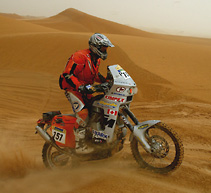 |
|
Bob making it look easy. Photo: Maindru Photo |
You know it’s easy to watch a half hour of TV coverage as people ride their bikes up and over sand dunes, in and out of camelgrass and at high speed over dry lake beds, and think what a blast it all must be. I did anyway, until I read the diaries of 2005 competitor Bob Bergman and was aghast at just how much preparation and utter commitment was required just to finish the thing.
When I finally put down his diaries I picked up my list of “things to do before I die” and promptly removed the Dakar. But that’s just me. Thankfully there are people of far greater determination and resilience out there than I, some of whom have actually done the Dakar.
CMG caught up with two of such Canadians at the Toronto Motorcycle Show; Lawrence Hacking and Guy Giroux and got the low down of what makes someone do such a thing as the Dakar. Oh, and if you want to know just what it’s like on a day in day out basis, then you should also check out Bob Bergman’s diaries which we published on CMG last year.
| Lawrence Hacking |
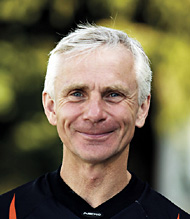 |
Lawrence started riding bikes back in his teens, first with motocross events and then enduros. In 1985 he entered and completed his first International Six Day Enduro (ISDE) going on to finish it four more times. A job with Yamaha Europe meant that he got to see the Rally des Pharaons and his interest in rallies was set.
In 2000 he decided to try to be the first Canadian to complete the Paris-Dakar rally. Nine months later – Jan 2001 – at the age of 46 and without any official factory support he was in Paris on a Honda XR650 …
PERSEVERANCE
My goal for the Dakar was to get through technical inspection, get into Africa and then just get to the rest day. I figured if I could get to the rest day I could finish. From past experience I knew that once you get past the halfway point you get stronger, your body adapts and you get more comfortable with everything.
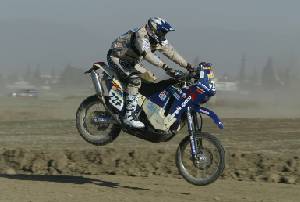 |
|
Photo: Maindru Photo |
Everything was going very well and so on the second day in Africa I was thinking, “Shoot, I can win this thing, I’ve got it in the bag! I’ll just pass all these guys … Why are they going so slowly?” And then I hit a big rock in the dust and bent the front wheel (he had to cut the lugs off the side of the tire to clear the fork and complete the remaining 500 kms in that shape until he got to base and swapped wheels).
The Dakar is the race that you can calculate the risk out of the least, but then it’s not about luck either; I don’t really believe in luck. There’s a good story about the golfer Arnold Palmer; a guy approached him and said, “Wow you made a great shot, you must be really lucky.” Arnold’s response to that was “Yes, the more I practice, the luckier I get!”
HIGHS AND LOWS
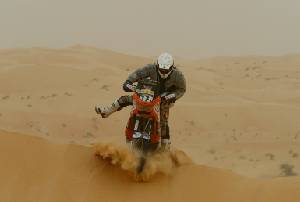 |
|
Check for drop-offs before launching over dunes! Photo: Maindru Photo |
The camelgrass was by far the toughest. There had been a lot of rainfall in the desert and the camelgrass root system retains the water, so the camelgrass becomes like a series of solid pylons throughout the desert … but not spaced quite far enough apart to make a straight line. When these big bikes are full of fuel they don’t want to turn that much, they just want to go straight.
The sand dunes are fun though. You know, you’re there to have fun and the sensation of riding sand is incredible! It’s like surfing; one key rule – never ever ride over something you can’t see because it could be 30 meters straight down, so you always put your front wheel over and have a look before going. Many people make a big mistake by not checking and just hoping for the best. You can’t – not in the Dakar, every meter can put you out of the rally.
You can also make some big serious mistakes in the dunes if you bury the bike and you’re all alone. I hit some soft spots, flopped over and fell in the sand – in 35-37 degree heat – and quickly figured I couldn’t do that more than three or four times each day or I’d be in trouble. So I was very careful – it’s much better to slow down and pick better lines.
LIFE AFTER DAKAR
 |
| What to do after the Dakar? Beijing – Ulaanbataar of course. |
I think that if you concentrate on things very intensely your mind gets better and better at concentrating. People warned me that when I got back home I’d feel like I’d have nothing to do, because you get so used to focusing with spoon-bending concentrating for 10 hours a day, and once back home you’re back to shoveling snow – it’s like your world is spinning around you.
The Dakar is all a test of who you are, to your ultimate ability, and it’s hard to describe what you go through during that race; we can tell you all about it but until you live that whole experience it’s pretty much impossible to convey it in its entirety.
It boils down to the sensation of riding motorcycles across that type of terrain. It’s really, really incredible – that’s what sold me on the event, seeing those guys on TV flying down the desert in total freedom, just the sensation of doing that – it’s the essence of motorcycling.
|
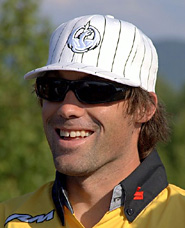 |
Guy started riding bikes at the very early age of five, taking part in his first race at the tender age of thirteen. Since then he has dominated the world of dirt in his home province of Quebec, becoming the provincial off-road champion no less than 13 times.
But his racing career spans far beyond La Belle Province, with three championships in the national off-road series and two top tens in the Pro Canadian MX. Oh and throw in a Bronze and Gold medal from the ISDE as well.
FOCUSED AND SMART
My goal was to finish, to make it to the end of that race. I had been training on a KTM but the first time I even saw the bike that I would use for the Dakar – a KTM 660 – was at the registration the day before the start!
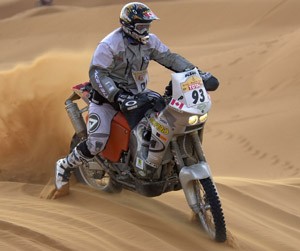 |
|
Guy tackling the dunes. Photo: Maindru Photo |
Right from the start I really paced myself as I knew I had to save my bike and my body if I was going to finish. I started off never going over 120 kph, and I didn’t make any mistakes. If you keep going 120 smart, instead of going 160 and making a mistake, you might actually make it to the end. But as the days went by and I started to get the hang of things, I was going faster and faster.
On day eight, we got lost because we had to go up a hill, and at the top the GPSs were pointing everywhere. Then I saw Jordi Arcarons, rider #3 (the low rider number signifying more experience) go to the other side; I watched him thought ah, he’s fucked if he goes that way, and I kept going on my route. He made the right choice though – if I had turned with him I would have got a top 5 finish that day. After that I learned that if someone had any number under five to follow him!
DISTRACTIONS
Three days from the end I was doing a TV interview with a crew in a helicopter while I was riding – using a microphone in my helmet. They had taken an interest in me because I was the fastest rising guy from the pack and wanted to ask me how the rally was going.
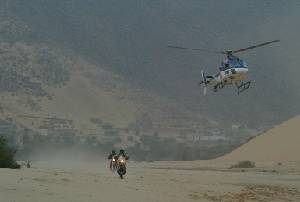 |
|
Getting on TV can be hazardous to your health! Photo: Maindru Photo |
Then, as soon as the live interview ended and the helicopter was flying away, I hit a soft spot and the bars started to flap – I went straight over them and landed on my head! The interviewers must have still been able to hear me in their headphones as my grunting from the crash brought the helicopter right back.
I got up and started looking for my bike and found it 50 feet back. All I could think about was my bike, and when the interviewers came back to ask what was happening I said, “Now I’m going to Dakar to the finish – I don’t give a shit, shut that mic down I don’t want to talk to you anymore!”
That crash left me with a dislocated vertebra and some sleepless nights from the pain. But also with the realization of how much of a mental thing the Dakar is – your ride is really so much in your head.
![]()
